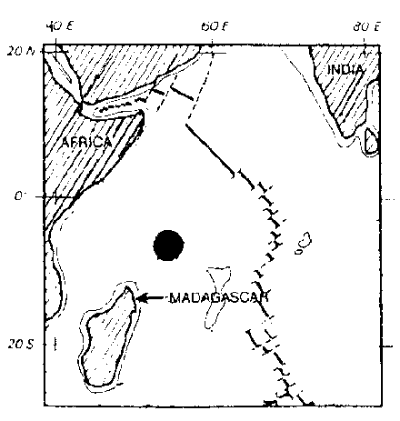 |
Science Frontiers ONLINE No. 47: Sep-Oct 1986 |
|
|
Two Points Of Great Impact
Geologists have been searching in vain for a large crater that might account for the biological extinctions at the Cretaceous-Tertiary boundary some 65 million years ago. C.J.H. Hartnady believes he had found the culprit. It is somewhat larger than expected (300 kilometers in diameter instead of 100200), but it is of the right age. Supporting this notion is the observation that the Seychelles Bank and Madagascar suddenly shifted their locations at about this time.
(Murray, M.; "Point of Impact: The Indian Ocean," Science News, 129:356, 1986.)
The existence of another terrestrial cat aclysm at an earlier date is suggested by a layer of shattered crustal rock fragments stretching over at least 260 kilometers in South Australia. Folded within Precambrian marine shales, these fragments reach 30 centimeters in diameter and show evidence of vertical fall. Evidence points to an origin near Lake Acraman, about 300 kilometers west.
(Gostin, Victor A., et al; "Impact Ejecta Horizon within Late Precambrian Shales, Adelaide Geosyncline, South Australia," Science, 233:198, 1986.)
Reference. The subject of very large terrestrial craters is discussed in ETC2 in our catalog: Carolina Bays, Mima Mounds. Description here.
 | The Amirante Basin (black circle) lies about 500 kilometers north-east of Madagascar. |